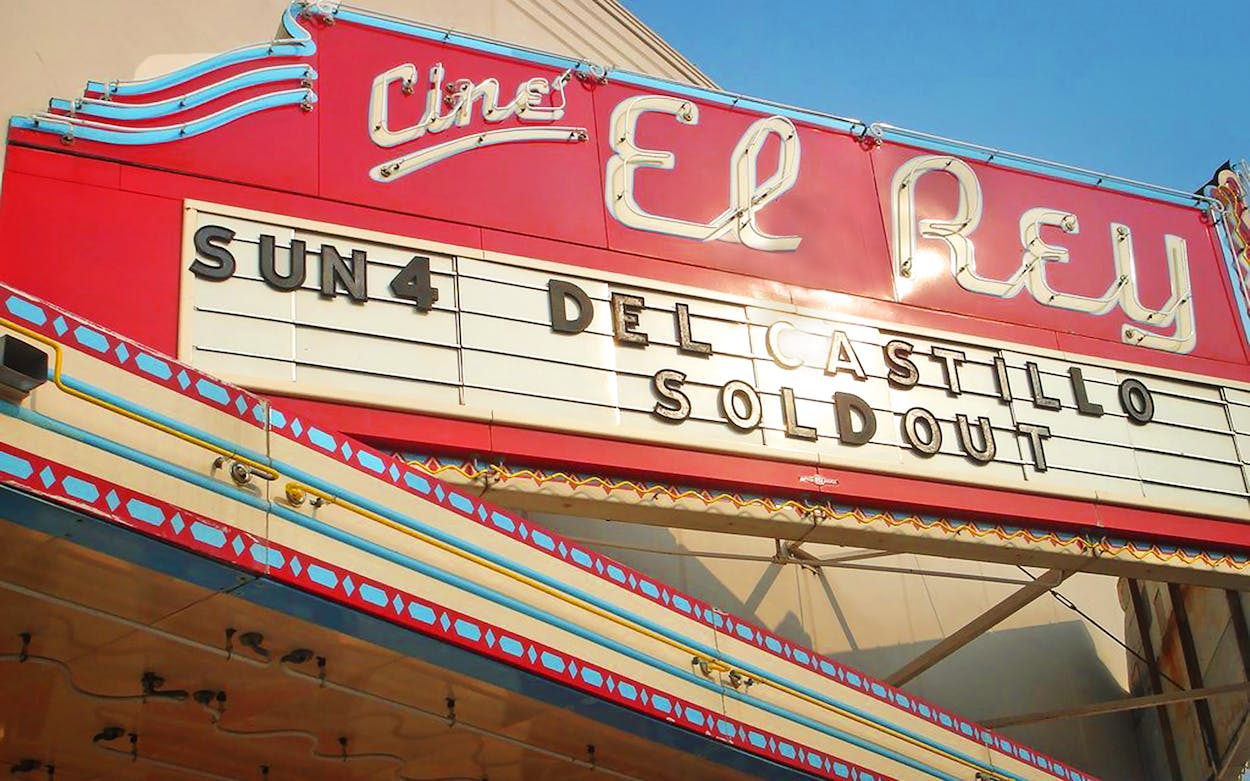If you ask people who work at McAllen’s Cine El Rey what they do for a living, they’ll tell you that they “make dreams come true.” For the last 73 years, dreamers have walked up to the theater and found themselves transfixed by its glamorous marquee, perhaps imagining their name up there one day. Family elders bear countless stories of giving it their all during talent shows at the theater, or meeting up with friends there to catch the latest pictures (or “vistas,” as my late cinephile grandfather would refer to them) from treasured legends of Mexican cinema such as Pedro Infante, Germán “Tin-Tan” Valdés, and Mario “Cantinflas” Moreno—stars who sometimes visited the theater on the opening nights of their films.
Much of this history has not been well documented, which means that these moments largely survive in the memories of people who were there. Velia Rangel, a McAllen native who worked the box office as a teenager in the early years, describes Cine El Rey as “the center of the Valley”; it hosted up to 1,200 guests on one of its busiest nights, a premiere for the 1952 film El Derecho de Nacer (“The Right to be Born”), which was a box-office hit in Mexico. If you were to play these scenes like a film on the theater’s own silver screen, you would never be able to guess that such joy could be found during a time of racial segregation in the Rio Grande Valley.
The theater, once the only place in town where Mexican residents could comfortably sit and watch a movie, eventually removed its permanent seating in order to host a greater diversity of events—a decision that remains controversial for some. Regardless, Cine El Rey has always risen to meet the needs of its community. After years of supporting its people, the theater now faces its greatest foe yet: the coronavirus. Unwilling to lose yet another cultural institution to history, the local community the theater has served for seven-plus decades has begun mobilizing to help keep it alive.

For the greater part of the twentieth century, McAllen, like the rest of the Rio Grande Valley, existed as a segregated community. White and nonwhite residents (largely Latinx communities of Mexican origin) were separated by train tracks that ran throughout every major city and town in South Texas. Cine El Rey, one of a handful of theaters that thrived within the confines of the South, “Mexican” side of McAllen, became a vital part of the area.
If the McAllen chapter of the American GI Forum wanted to host free screenings of Christmas movies for the neighborhood, they looked toward Cine El Rey. If local musicians and amateur performers alike wanted to show the world what they were made of, or if local grassroots organizers needed a meeting to plan a fight against police brutality in the city, they knew they could do so at the theater. In an interview with KRGV Channel 5, Sister Norma Pimentel, executive director of Catholic Charities of the Rio Grande Valley, the charitable branch of the Diocese of Brownsville, described the theater as “a place for some people to be a safe haven, because they find themselves a space to be themselves and voice who they are.”
Still, the building’s various owners have long struggled to keep it open. Following a depression in the Mexican film industry and the opening of a brand new theater in town in 1988, Cine El Rey resigned itself to being a “dollar theater,” screening second-run American films only, according to current owner Bert Guerra. Later, in 1996, it reopened as a religious outreach center but shuttered after just two years. In 1999, the theater was purchased by Luis Muñoz, who renovated the space in 2001 and had it listed in the National Register of Historic Places by the U.S. Department of the Interior the following year. When brothers Isaac and Bert Guerra bought it in 2007, the theater was struggling to survive on screening films alone. Considering that the downtown McAllen area had just become the city’s new entertainment district, the two Premont natives took it upon themselves to open the theater to new audiences. (While Isaac is a co-owner, Bert handles the majority of the theater’s day-to-day operations.)
After they bought Cine El Rey, the Guerras invited amateur and professional filmmakers, in addition to theater companies, to host their productions there. The brothers also reached out to show promoters in metal, goth, industrial, and dance music scenes, among others, as well as young comedians looking to practice their material. Even aspiring professional wrestlers looking to build their own wrestling company began booking regular showcases at Cine El Rey. From 2007 on, it wasn’t just a historic theater: it quickly became a hub for live entertainment in the Valley.
Patrick Garcia, one of the Valley’s most prominent show promoters and a booking agent in the alternative music and arts scene, has built his own booking company, Tiger’s Blood, out of a longstanding working relationship with the venue. When Garcia began booking bigger touring acts, he needed a space that could accommodate an audience that was too large for, say, a VFW hall but too small for an arena. The theater’s size, along with its rich history and Bert’s commitment, support, and experience (Guerra previously worked in the music industry for 37 years), made it the perfect candidate. “There were other spaces that were interested in making themselves available, but I like working specifically with Bert,” Garcia says. “Everybody wants to be recognized, but it’s different when someone says, ‘I believe in you.’” Many well-established touring artists Tiger’s Blood has booked over the past decade, both for one-off shows and local festivals like Galax Z Fair, have introduced multiple generations of show-goers to the theater, and have drawn out older music fans out for artists like the Zombies.
I can’t overstate how important Cine El Rey has been in my own trajectory as an artist. One show in particular sticks out as the single most influential moment in my life as a musician, documentarian of the local music scene, and, most importantly, a visible figure in my community with a responsibility to do what’s right by the people who live here. On September 26, 2014, 43 college students disappeared in Mexico, and are suspected to have been killed by the Mexican government. Their parents and relatives created a campaign to spread awareness throughout the United States, in hopes that it could draw enough attention to pressure the Mexican government to return their children or, at the very least, address their complicity in the students’ disappearance.
The campaign, named Caravana 43, began its first tour of the United States in McAllen on March 16, 2015, beginning with a panel at South Texas College, a march from the LUPE (La Union Del Pueblo Entero) center to the Basilica of Our Lady of San Juan del Valle for a vigil, and ending the next day with a march from McAllen’s historic Archer Park to the Mexican Consulate’s office several blocks away. More than one hundred people chanted along with the relatives of the disappeared students, calling for justice in unison for a little over an hour.
It also happened to be the first day of the fourth annual Galax Z Fair festival, which was spread out over two stages: the main stage inside Cine El Rey and the outdoor stage at the Thirsty Monkey, a bar around the corner. The lineup boasted sets by legendary punk groups such as the Spits and the Screaming Females, alongside high-profile younger bands like Iceage and Lust For Youth; I had committed to managing the outdoor stage. Halfway through the first day of the festival, local organizers who had facilitated the caravana’s visit to McAllen reached out and asked if the disappeared students’ relatives would be able to speak at the festival. Garcia, who had organized the event with Tiger’s Blood, approved it with enthusiasm.
After speaking at the outdoor stage, the relatives headed over to Cine El Rey and took the stage while a band was setting up in front of a crowd of about three hundred people. In Spanish, the students’ relatives shared their stories, pointing out that their loved ones would be not much older than a majority of the people listening to them in that room. They spoke about how their loved ones also enjoyed music. I will never forget the silence in that room for the rest of my life. This moment gave me hope that this place can look out for itself, and that its people have the capacity to understand and look out for each other.

As a young boy, Cine co-owner Bert Guerra went on a field trip with his class to see The Wizard of Oz at the Rig Theatre, in Premont. Mistaking the permission slip for a disciplinary note, he hid it from his parents, and was unable to get money to pay for snacks or admission; he vividly remembers the person at the theater that day who withheld a bag of popcorn from him. “They told my teacher, ‘I’ll let him into the movie, but I’m not going to give him popcorn,’” he says. “I was just kind of like, ‘Why can’t you just give it to me?’” Guerra then spent the whole screening trying to ignore his classmates carelessly throwing their own popcorn kernels at the screen. “I remember promising to God, ‘If I ever get my own theater, I’m gonna give away my own popcorn,’” he says. He made good on his promise: before the pandemic struck, Cine El Rey would host film screenings every Tuesday that were free to the public, and every patron who walked through the door was given a free bag of freshly popped popcorn.
Guerra says that these exclusionary experiences, in addition to the theater’s decades-long fight to survive within a community that had been confined to boundaries beyond its control, is what drives him to run the venue the way he does. “It’s representative of what I like to say the Apollo is for Hispanics, even though we never got to a level to say we’re like the Apollo, but culturally, this is all we got,” he says, referencing stories of Valley icons like Baldemar Huerta, who went by the musical moniker Freddy Fender, and Carlos Guzman taking the stage early in their careers. “Anybody can take this over, but who’s gonna lose out? You might lose out on live music, you might lose out on comedy, it might just become a club or a wrestling event center. But isn’t it neat that it could still do all these things right now?”
When the COVID-19 pandemic began spreading throughout the Rio Grande Valley in March, the live music and film industries came to a halt. Having made most of its income from live music events, Cine El Rey was suddenly thrust into a crisis. Guerra says the theater’s monthly expenses—which include pay for its workers, utilities, and maintenance (a constant for a venue of its age and sheer size) add up to about $30,000 per month. That income stream vanished practically overnight. With the consensus among artists and booking agents that no live music events would be booked for the remainder of 2020, Cine El Rey—along with other Valley venues like Half-Moon Saloon, Hop Shop, Yerberia Cultura, and the Flying Walrus—suddenly joined a wave of countless cultural institutions whose futures remain uncertain.
Unlike the owners of some local landmarks, the Guerras have never allowed the influence of outside investors, politicians, or heavy-pocketed community members to help them keep the lights on. The funds that help the theater host free events like film screenings, open mics, and weekly local band showcases come from the fund-raising efforts of The Historic Cine El Rey Theatre Foundation, a nonprofit that the Guerra brothers created with their sister, Lebby Salinas, to raise money for philanthropic ventures throughout the community such as the theater’s annual MLK Day march and annual Food Allergy Awareness walk. (The foundation also kickstarted the Grow’n Growers Farmer’s Market that takes place at Fireman’s Park.) But with mass gatherings on hold for now, and even in the wake of the government reopening Texas, the foundation also has found it difficult to sustain itself and keep the venue afloat.
Since Cine El Rey is technically a business and not a nonprofit, Bert applied for aid funding that the federal government made available to small businesses after the early weeks of the pandemic. Because the venue doesn’t have any full-time employees, he was denied funding. Not unlike other establishments suffering throughout the country, Cine’s bartenders work part-time hours; even Bert himself, while handling all of the light and sound work for the venue as well as daily duties, is not employed by the theater and makes no profit from its business (a decision he made with the intention of putting as much money back into it as possible). Coupled with Bert’s fervent opposition to accepting money from big donors, Cine El Rey appeared to be out of options.
But when Bert started looking back to the theater’s roots, he found a potential solution. He concluded that the only way the venue could get through the year was if it could amass donations from members of the community who had found a place for themselves there. So he took to the foundation’s website and re-upped a 2013 YouTube video the nonprofit used to fundraise, and asked for donations to benefit the theater. In it, prized Valley native Valente Rodriguez, best known for playing Ernie on The George Lopez Show in the nineties and aughts, speaks about the many formative experiences he had because of Cine El Rey—ones that informed his career as a successful actor in Hollywood. “[Cine El Rey] is a symbolic theater that represents regional arts and culture, and celebrates the human spirit that is within all of us,” he says. “No matter where I travel, my heart and soul are here … So it is an honor to give back to the place that has given me my future.”
Bert named the Cine El Rey donation campaign “Give Five to Keep Cine El Rey Alive,” because many people who have frequented the theater are also part of the city’s lower-income demographic, and may find a donation amount above five dollars intimidating. He believes that this low price could possibly encourage patrons to donate confidently. As of May 2020, Cine El Rey’s “Give Five” campaign had raised roughly $11,000 dollars. Bert believes that if he can receive at least one donation from each of the theater’s twenty thousand Facebook followers, the venue would be able to raise $100,000—enough to sustain it throughout the summer and prepare for surviving the fall.
Considering the rising rates of coronavirus cases in the Valley, the pandemic shows no signs of going away soon. Nonetheless, Bert remains hopeful that people will find it in themselves to give something back. Musicians throughout the Valley have already been raising funds through livestreamed performances to support the venue. (A live performance series that I run through the Instagram account of my record label, Universal Punk, has encouraged performers to raise funds for worthy causes if they do not need to raise funds for themselves.) Artists including Blocked Numbers and Dezorah have used their performances to raise money for the theater, too.
“As a musician, not being able to play live shows has removed half of the fun of making music,” says Robert Godinez, who plays electronic post-punk music under the name Blocked Numbers. “I wanted to support Cine El Rey because it’s been the location of some milestone performances for me. I want future generations to be able to leave their mark on it and create their own milestones there.”
Updates 06/17: This story has been amended to include more information about Cine El Rey’s previous owners, and that a young Bert Guerra mistook his family’s permission slip for a disciplinary note.






